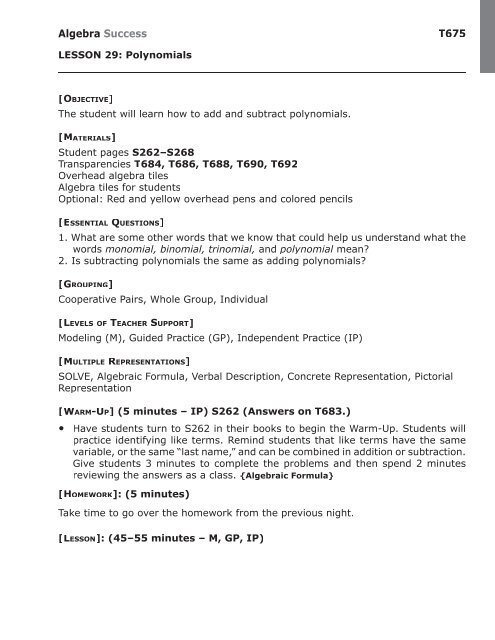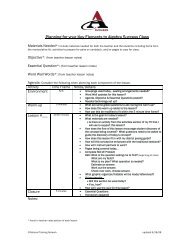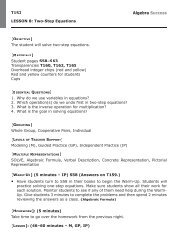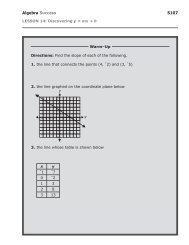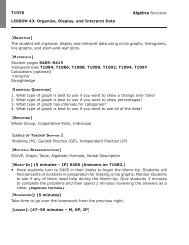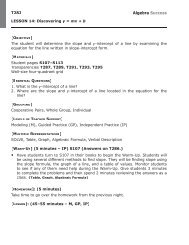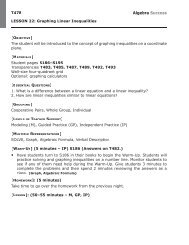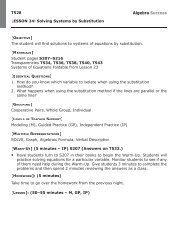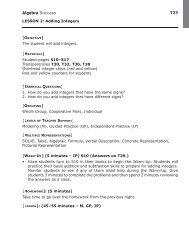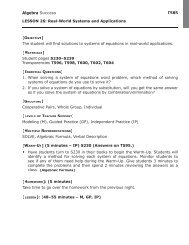Lesson 26-30 6.0 p.indd
Lesson 26-30 6.0 p.indd
Lesson 26-30 6.0 p.indd
You also want an ePaper? Increase the reach of your titles
YUMPU automatically turns print PDFs into web optimized ePapers that Google loves.
Algebra Success<br />
T675<br />
LESSON 29: Polynomials<br />
[OBJECTIVE]<br />
The student will learn how to add and subtract polynomials.<br />
[MATERIALS]<br />
Student pages S<strong>26</strong>2–S<strong>26</strong>8<br />
Transparencies T684, T686, T688, T690, T692<br />
Overhead algebra tiles<br />
Algebra tiles for students<br />
Optional: Red and yellow overhead pens and colored pencils<br />
[ESSENTIAL QUESTIONS]<br />
1. What are some other words that we know that could help us understand what the<br />
words monomial, binomial, trinomial, and polynomial<br />
mean<br />
2. Is subtracting polynomials the same as adding polynomials<br />
[GROUPING]<br />
Cooperative Pairs, Whole Group, Individual<br />
[LEVELS OF TEACHER SUPPORT]<br />
Modeling (M), Guided Practice (GP), Independent Practice (IP)<br />
[MULTIPLE REPRESENTATIONS]<br />
SOLVE, Algebraic Formula, Verbal Description, Concrete Representation, Pictorial<br />
Representation<br />
[WARM-UP] (5 minutes – IP) S<strong>26</strong>2 (Answers on T683.)<br />
• Have students turn to S<strong>26</strong>2 in their books to begin the Warm-Up. Students will<br />
practice identifying like terms. Remind students that like terms have the same<br />
variable, or the same “last name,” and can be combined in addition or subtraction.<br />
Give students 3 minutes to complete the problems and then spend 2 minutes<br />
reviewing the answers as a class. {Algebraic Formula}<br />
[HOMEWORK]: (5 minutes)<br />
Take time to go over the homework from the previous night.<br />
[LESSON]: (45–55 minutes – M, GP, IP)
T676<br />
Algebra Success<br />
LESSON 29: Polynomials<br />
SOLVE Problem<br />
(5 minutes – GP) T684, S<strong>26</strong>3 (Answers on T685.)<br />
Have students turn to S<strong>26</strong>3 in their books, and place T684 on the overhead. The<br />
first problem is a SOLVE problem. You are only going to complete the S step with<br />
students at this point. Tell students that during the lesson they will learn how<br />
to add and subtract polynomials. They will use this knowledge to complete this<br />
SOLVE problem at the end of the lesson. {SOLVE}<br />
Algebra Tiles (7 minutes – M)<br />
Pass out the algebra tiles to each student. Use the following activity to introduce<br />
the algebra tiles to students. {Algebraic Formula, Verbal Description, Concrete<br />
Representation, Pictorial Representation}<br />
MODELING<br />
Introduce Algebra Tiles<br />
Step 1: Review the definition of monomial with students. A monomial is one term<br />
which is a number, a variable, or the product of the two.<br />
Examples of monomials: 5x, xy 2 , 8, 9mn 3 .<br />
Step 2: Write binomial, trinomial, and polynomial on the board or overhead. Ask<br />
your students if the prefixes of the words give them any clues to their<br />
meaning. (Students may know that poly means “many,”<br />
bi means “two,”<br />
and tri<br />
means “three.” It is possible to lead them to the meanings of bi<br />
and tri by asking about the number of wheels on a bicycle or tricycle.)<br />
A binomial is the sum of two monomials. A trinomial is the sum of three<br />
monomials. A polynomial is the sum of two or more monomials.<br />
Examples of binomials: x + 2,<br />
y +<br />
x, 2x x + 4<br />
y<br />
Examples of trinomials: x 3 + 3x x + 6,<br />
y 2 + 2y y + 1,<br />
x 2 + xy +<br />
y 2<br />
Examples of polynomials: x 3 + 4x 2 + 5, x + 5,<br />
x 3 + x 2 y +<br />
y 2 , x + y<br />
Step 3: Pass out the algebra tiles. Introduce the ones tiles first. Tell students to<br />
put the small yellow square on their desks. Put one small yellow square<br />
on the overhead. Explain that the small yellow square represents the<br />
number 1. Ask students how they would represent the number 4. (with 4<br />
small yellow squares) Put 4 small yellow squares on the overhead.<br />
Repeat this process with the small red squares, each of which represents<br />
- 1. Show<br />
- 4,<br />
- 6, and<br />
- 2 using the small red squares.
Algebra Success<br />
T677<br />
LESSON 29: Polynomials<br />
Step 4: Introduce the x<br />
tiles. Tell students to put one of the long yellow pieces<br />
on their desks. Ask them how long they think this piece is. Let students<br />
guess the length of the long piece. Place one long yellow piece (one yellow<br />
x tile) on the overhead. Tell students that the length of the long piece<br />
is not known. Ask students what they use in mathematics to represent<br />
something that they do not know. They should say that they use a variable.<br />
Explain that the long piece’s length is x<br />
units, so students should refer to<br />
the long pieces as x tiles.<br />
Have students compare the width of the x<br />
tile to that of a small square.<br />
They will see that the x<br />
tile has the same width as a small square. Explain<br />
that this means that the x<br />
tile has a width of 1, so the area of the<br />
x<br />
tile<br />
is 1 • x, or x. Place 4 yellow x tiles together on the overhead and have<br />
students do the same on their desks. Explain that because 1 yellow x<br />
tile represents 1x, or x, 4 yellow x<br />
tiles represent 4x. Do a few more<br />
examples with students.<br />
Repeat this process with the long red pieces (red x tiles), each of which<br />
represents - 1x, or - x.<br />
Step 5: Introduce the x 2 tiles. Have students put one of the large yellow squares<br />
on their desks. Put one on the overhead. Tell students that they have to<br />
come up with a name for this piece. Tell them to use a yellow x<br />
tile to<br />
measure the length and width of the large square. Help students see that<br />
each side of the large square is x units long. Thus, the area of the large<br />
square is x •<br />
x, or x 2 . Tell students that they should refer to the large<br />
yellow squares as x 2 tiles.<br />
Repeat this process with the large red squares (red x 2 tiles), each of<br />
which represents - x 2 .<br />
Add Polynomials<br />
(8 minutes – (M, GP) T684, S<strong>26</strong>3 (Answers on T685.)<br />
Use the following activity to model for students how to add polynomials at the<br />
concrete level using the overhead algebra tiles. Students should model the<br />
problems at their desks using their red and yellow algebra tiles. {Algebraic Formula,<br />
Verbal Description, Concrete Representation, Pictorial Representation}
T678<br />
Algebra Success<br />
LESSON 29: Polynomials<br />
MODELING<br />
Add Polynomials<br />
Step 1: Discuss the process of addition before you begin to model the first problem.<br />
If you were going to teach addition to first graders, you might put 3<br />
apples on one side of your desk and 4 apples on the other side. Then, to<br />
add 3 apples and 4 apples, you would push together, or combine, the two<br />
groups to get 7 apples. You will show students how to add polynomials in<br />
the exact same way—by representing the first polynomial and the second<br />
polynomial as two separate groups and then pushing the two groups<br />
together.<br />
Step 2: For Problem 1, have students first represent x 2 + 3x x + 1 using 1 yellow<br />
x 2 tile, 3 yellow x<br />
tiles, and 1 small yellow square. Then have students<br />
represent 2x 2 + 5x x<br />
+ 3 using 2 yellow x 2 tiles, 5 x<br />
tiles, and 3 small yellow<br />
squares.<br />
Step 3: Have students push the two groups together. Explain that students should<br />
put all the x 2 tiles together and all the x<br />
tiles together. Tell students that<br />
doing this is combining like terms.<br />
Step 4: Once the like terms are combined, students should see that the answer<br />
is 3 yellow x 2 tiles, 8 yellow x<br />
tiles, and 4 small yellow squares, or<br />
3x 2 + 8x x + 4.<br />
Step 5: For Problem 2, have students represent 2x 2 + 5x x – 2 using 2 yellow<br />
x 2 tiles, 5 yellow x tiles, and 2 small red squares. Then have students<br />
represent x 2 – 7x x<br />
+ 5 using 1 yellow x 2 tile, 7 red x<br />
tiles, and 5 small<br />
yellow squares.
Algebra Success<br />
T679<br />
LESSON 29: Polynomials<br />
Step 6: Have students push the two groups together and combine like terms.<br />
Once the like terms are combined, explain to students that they need to<br />
have the x<br />
tiles all in one color and the small squares all in one color. To<br />
do this, students should form zero pairs.<br />
Have students form zero pairs from 5 yellow x tiles and 5 red<br />
x tiles. Have<br />
students cancel the zero pairs one at a time. Then have students form<br />
zero pairs from 2 small yellow squares and 2 small red squares and then<br />
cancel the zero pairs one at a time. Once the canceling of zero pairs is<br />
complete, students should see that the answer is 3 yellow x 2 tiles, 2 red<br />
x tiles, and 3 small yellow squares, or 3<br />
x 2 – 2x x + 3.<br />
Step 7: After students have modeled the problems with the algebra tiles, have<br />
them go back and model each problem pictorially as you do the same on<br />
T684. Answers are shown on T685.<br />
Add and Subtract Polynomials<br />
(10 minutes – M, GP) T686, S<strong>26</strong>4<br />
(Answers on T687.)<br />
Have students turn to S<strong>26</strong>4 in their books, and place T686 on the overhead. Use<br />
the following activity to model for students how to add and subtract polynomials<br />
at the concrete level using the overhead algebra tiles. Students should model<br />
the problems at their desks using their red and yellow algebra tiles. {Algebraic<br />
Formula, Verbal Description, Concrete Representation, Pictorial Representation}
T680<br />
Algebra Success<br />
LESSON 29: Polynomials<br />
MODELING<br />
Add and Subtract Polynomials<br />
Step 1: For Problem 3, have students represent 3x 2 – 7x x + 5 using 3 yellow<br />
x 2 tiles, 7 red x tiles, and 5 small yellow squares. Then have students<br />
represent x 2 – x<br />
– 6 using 1 yellow x 2 tile, 1 red x<br />
tile, and 6 small red<br />
squares.<br />
Step 2: Have students push the two groups together and combine like terms.<br />
Once the like terms are combined, explain to students that they need to<br />
have the small squares all in one color. To do this, students should form<br />
zero pairs.<br />
Have students form zero pairs from 5 small yellow squares and 5 small red<br />
squares and then cancel the zero pairs one at a time. Once the canceling<br />
of zero pairs is complete, students should see that the answer is 4 yellow<br />
x 2 tiles, 8 red x tiles, and 1 small red square, or<br />
4x 2 – 8x x – 1.<br />
Step 3: Before modeling Problem 4, remind students about the rules for subtracting<br />
integers. Explain that students will represent the first polynomial and take<br />
away the second polynomial. If they need to take away something that is<br />
not there, they will create the possibility by adding zero pairs.<br />
Step 4: For Problem 4, have students represent 2x 2 + 5x x – 4 using 2 yellow<br />
x 2<br />
tiles, 5 yellow x tiles, and 4 small red squares. Explain to students that<br />
the problem asks students to take away x 2 + 3x x + 1, which is 1 yellow x 2<br />
tile, 3 yellow x tiles, and 1 small yellow square.<br />
Step 5: Model for students how to take away the yellow x 2 tile and the 3 yellow<br />
x<br />
tiles. Explain that students do not have a small yellow square to take<br />
away, so they must create the possibility. Model for students how to add<br />
a zero pair (1 small yellow square and 1 small red square) and then<br />
take away 1 small yellow square. Students should see that the answer is<br />
x 2 + 2x x – 5.
Algebra Success<br />
T681<br />
LESSON 29: Polynomials<br />
Step 6: Another way to solve the same problem is to use your rules for subtracting<br />
integers. Remind students that subtracting is the same as adding the<br />
opposite. For Problem 4, model for students how to distribute the<br />
subtraction sign to all terms in the second polynomial and rewrite the<br />
problem as an addition problem.<br />
(2x 2 + 5x x – 4) – (<br />
x 2 + 3x x + 1) = (2<br />
x 2 + 5x x – 4) +<br />
(2x 2 + 5x x – 4) + (<br />
- x<br />
2<br />
– 3x x – 1)<br />
- 1(x<br />
2<br />
+ 3x x + 1) =<br />
Step 7: Have students model the two polynomials, push them togethers and<br />
combine like terms, and then cancel zero pairs. Students should see that<br />
the answer is the same as the one they found when they subtracted,<br />
x 2 + 2x x – 5.<br />
Repeat Steps 3–7 above to model Problem 5 with students. After students have<br />
modeled Problems 3–5 on S<strong>26</strong>4 (T686) with the algebra tiles, have them go back<br />
and model each problem pictorially as you do the same on T686. Answers are<br />
shown on T687.<br />
If time permits...<br />
(10 minutes – IP) T688, S<strong>26</strong>5 (Answers on T689.)<br />
Have students complete Problems 1–4 on S<strong>26</strong>5 (T688). Have students model<br />
each problem with their algebra tiles and then pictorially. Students can work in<br />
cooperative pairs or independently. Give students 8 minutes to complete the<br />
problems and then use 2 minutes to review the answers. {Algebraic Formula,<br />
Verbal Description, Concrete Representation, Pictorial Representation}<br />
No Algebra Tiles<br />
(10 minutes – M, GP) T690, S<strong>26</strong>6 (Answers on T691.)<br />
Have students turn to S<strong>26</strong>6 in their books, and place T690 on the overhead. Model<br />
Problems 5–10 with students without using algebra tiles. Have students change<br />
each subtraction problem to an addition problem before finding the difference.<br />
{Algebraic Formula, Verbal Description}<br />
SOLVE Problem<br />
(5 minutes – GP) T692, S<strong>26</strong>7 (Answers on T693.)<br />
Remind students that the SOLVE problem is the same one from the beginning of<br />
the lesson. Complete the SOLVE problem with your students. {SOLVE, Algebraic<br />
Formula}
T682<br />
Algebra Success<br />
LESSON 29: Polynomials<br />
[CLOSURE]: (5 minutes)<br />
• To wrap up the lesson, go back to the essential questions and discuss them with<br />
students.<br />
• What are some other words that we know that could help us understand what<br />
the words monomial, binomial, trinomial, and polynomial<br />
mean (polygon,<br />
bicycle, tricycle, triangle)<br />
• Is subtracting polynomials the same as adding polynomials (Subtraction is<br />
not exactly the same as adding. Subtraction is adding the opposite.)<br />
[HOMEWORK]: Assign S<strong>26</strong>8 for homework. (Answers on T694.)<br />
[QUIZ ANSWERS] T695–T696<br />
1. D 2. B 3. A 4. C 5. A 6. B 7. A 8. D 9. B 10. D<br />
The quiz can be used at any time as extra homework or to see how students did on<br />
understanding adding and subtracting polynomials.


